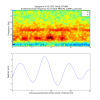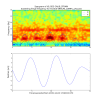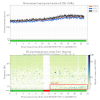[Sheila, Jenne, Travis, JeffK, EvanH]
The transmitted powers through the IFO are dropping on a several-hour timescale, and we don't know why. It looks like this was also happening at the end of yesterday's 31 hour lock. (POP_LF is shown for the last day or so in the attached plot.) These are the only 2 locks in the last 10 days that have this trend - for all the others the powers stay nice and steady.
The power into the interferomter as measured by both IMC_Trans and IM4_Trans is steady, so it's not anything from the PSL or IMC.
We have looked at all the alignment and length control signals that we can think of, as well as the witness channels on the bottoms of the optics, and we aren't seeing anything that jumps out at us as a cause of this power drop.
Intriguingly, the REFL power is dropping as well as the transmitted powers, so perhaps we're losing our mode matching throughout the lock? Sheila found that the TCS CO2 power is different after Tuesday maintenence this week, although it's not changing throughout these locks.
Anyhow, we're not sure what is wrong, so we're not sure what we would tweak if we could, so we're leaving the IFO alone. But, I suspect that once POP_LF gets down near 15,000 counts we'll lose this lock.
























